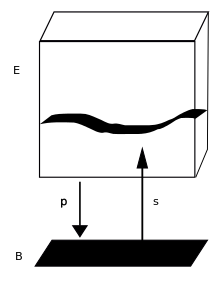


In the mathematical field of topology, a section (or cross section)[1] of a fiber bundle is a continuous right inverse of the projection function . In other words, if is a fiber bundle over a base space, :
then a section of that fiber bundle is a continuous map,
such that
- for all .
A section is an abstract characterization of what it means to be a graph. The graph of a function can be identified with a function taking its values in the Cartesian product , of and :
Let be the projection onto the first factor: . Then a graph is any function for which .
The language of fibre bundles allows this notion of a section to be generalized to the case when is not necessarily a Cartesian product. If is a fibre bundle, then a section is a choice of point in each of the fibres. The condition simply means that the section at a point must lie over . (See image.)
For example, when is a vector bundle a section of is an element of the vector space lying over each point . In particular, a vector field on a smooth manifold is a choice of tangent vector at each point of : this is a section of the tangent bundle of . Likewise, a 1-form on is a section of the cotangent bundle.
Sections, particularly of principal bundles and vector bundles, are also very important tools in differential geometry. In this setting, the base space is a smooth manifold , and is assumed to be a smooth fiber bundle over (i.e., is a smooth manifold and is a smooth map). In this case, one considers the space of smooth sections of over an open set , denoted . It is also useful in geometric analysis to consider spaces of sections with intermediate regularity (e.g., sections, or sections with regularity in the sense of Hölder conditions or Sobolev spaces).
YouTube Encyclopedic
-
1/5Views:4 73214 9395 91814 5117 480
-
Introduction to Fiber Bundles part 1: Definitions
-
Principal fibre bundles - Lec 19 - Frederic Schuller
-
What is a Manifold? Lesson 12: Fiber Bundles - Formal Description
-
Construction of the tangent bundle - Lec 10 - Frederic Schuller
-
Associated fibre bundles - Lec 20 - Frederic Schuller
Transcription
Local and global sections
Fiber bundles do not in general have such global sections (consider, for example, the fiber bundle over with fiber obtained by taking the Möbius bundle and removing the zero section), so it is also useful to define sections only locally. A local section of a fiber bundle is a continuous map where is an open set in and for all in . If is a local trivialization of , where is a homeomorphism from to (where is the fiber), then local sections always exist over in bijective correspondence with continuous maps from to . The (local) sections form a sheaf over called the sheaf of sections of .
The space of continuous sections of a fiber bundle over is sometimes denoted , while the space of global sections of is often denoted or .
Extending to global sections
Sections are studied in homotopy theory and algebraic topology, where one of the main goals is to account for the existence or non-existence of global sections. An obstruction denies the existence of global sections since the space is too "twisted". More precisely, obstructions "obstruct" the possibility of extending a local section to a global section due to the space's "twistedness". Obstructions are indicated by particular characteristic classes, which are cohomological classes. For example, a principal bundle has a global section if and only if it is trivial. On the other hand, a vector bundle always has a global section, namely the zero section. However, it only admits a nowhere vanishing section if its Euler class is zero.
Generalizations
Obstructions to extending local sections may be generalized in the following manner: take a topological space and form a category whose objects are open subsets, and morphisms are inclusions. Thus we use a category to generalize a topological space. We generalize the notion of a "local section" using sheaves of abelian groups, which assigns to each object an abelian group (analogous to local sections).
There is an important distinction here: intuitively, local sections are like "vector fields" on an open subset of a topological space. So at each point, an element of a fixed vector space is assigned. However, sheaves can "continuously change" the vector space (or more generally abelian group).
This entire process is really the global section functor, which assigns to each sheaf its global section. Then sheaf cohomology enables us to consider a similar extension problem while "continuously varying" the abelian group. The theory of characteristic classes generalizes the idea of obstructions to our extensions.
See also
Notes
- ^ Husemöller, Dale (1994), Fibre Bundles, Springer Verlag, p. 12, ISBN 0-387-94087-1
References
- Norman Steenrod, The Topology of Fibre Bundles, Princeton University Press (1951). ISBN 0-691-00548-6.
- David Bleecker, Gauge Theory and Variational Principles, Addison-Wesley publishing, Reading, Mass (1981). ISBN 0-201-10096-7.
- Husemöller, Dale (1994), Fibre Bundles, Springer Verlag, ISBN 0-387-94087-1
External links
- Fiber Bundle, PlanetMath
- Weisstein, Eric W. "Fiber Bundle". MathWorld.





































